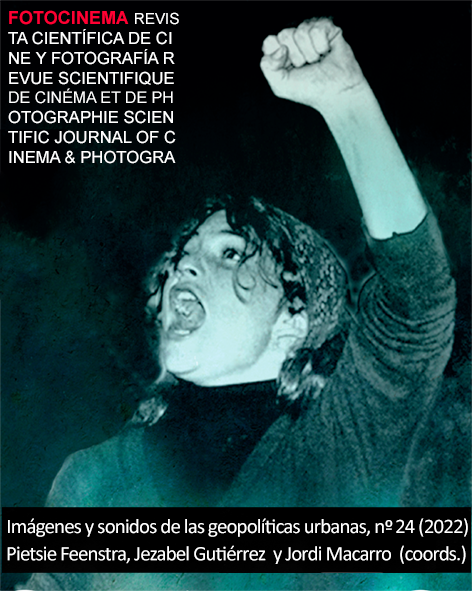Urban Youth: City, body, virtuality in Latin American cinema (Chile, Argentina and Mexico)
Abstract
This article analyzes the representation of current youth in the urban setting in Latin American fiction cinema, addressing various tensions related to a changing city, away from its traditional representation and adapted to the performative identity of young people, who provide a sensitive sense to the spaces they inhabit. The analysis will focus on the films Ya no estoy aquí by Fernando Frías (Mexico, 2019), Ema by Pablo Larraín (Chile, 2019) and El auge del humano by Eduardo Williams (Argentina, 2016), all starring adolescents. In them we identify verbally hermetic characters who emancipate themselves in their urban wandering, building fabrics or transit surfaces where both their artistic/cultural affinities and their immersion in the digital world; all this considering the mediation of the local context of the characters and their belonging to a globalized community.
Downloads
Metrics
Publication Facts
Reviewer profiles N/A
Author statements
Indexed in
-
—
- Academic society
- N/A
- Publisher
- Universidad de Málaga
References
Arfuch, L. (2020). Andar en las ciudades. Berlín/Buenos Aires. En F. Pietsie & L. Verzero (Eds.), Ciudades performativas: prácticas artísticas y políticas de (des)memoria en Buenos Aires, Berlín y Madrid (pp. 37-48). Buenos Aires: Universidad de Buenos Aires / Instituto de Investigaciones Gino Germani.
Augé, M. (2000). Los no lugares. Espacios del anonimato. Antropología de la Sobremodernidad. Barcelona: Gedisa.
Baricco, A. (2013). The Barbarians: An Essay on the Mutation of Culture. New York: Rizzoli Ex Libris.
Bauman, Z. (2018). Generación líquida: Transformaciones en la era 3.0. Barcelona: Paidós.
Chion, M. (1997). La música en el cine. Barcelona: Paidós.
Imbert, G. (2019). Crisis de valores en el cine posmoderno (más allá de los límites). Madrid: Cátedra.
Jullier, L. (2007). El sonido en el cine. Barcelona: Paidós.
Leo?n, C. (2005). El cine de la marginalidad. Realismo sucio y violencia urbana. Quito: Corporación Editora Nacional / Ediciones Abya Yala.
Mongin, O. (2006). La condición urbana. La ciudad a la hora de la mundialización. Buenos Aires: Paidós.
Ramírez Varela, F. (2020). Juventud y movimientos sociales: reflexiones sobre la Generacio?n Glocal latinoamericana. Revista Argentina de Estudios de Juventud, (14), e030. doi: 10.24215/18524907e030
Roncallo Row, S. & Uribe-Jongbloed, E. (2017). La este?tica de los videoclips: propuesta metodolo?gica para la caracterizacio?n de los productos audiovisuales musicales. Cuadernos de Mu?sica, Artes Visuales y Artes Esce?nicas, 1(12), 79-109. doi: 10.11144/Javeriana.mavae12-1.evpm
Rueda, C. (2019). Ciudad y fantasmagoría: dimensiones de la mirada en el cine urbano de. Latinoamérica del siglo XXI. Santiago: Cuarto Propio.
Soja, E. (2008). Postmetrópolis. Estudios críticos sobre ciudades y regiones. Madrid: Traficantes de Sueños.
Verzero, L. (2020). Teatralidad, memoria y experiencia en la ciudad-cuerpo: pra?cticas performa?ticas en la Buenos Aires del siglo XXI. En F. Pietsie & L. Verzero (Eds.), Ciudades performativas: prácticas artísticas y políticas de (des)memoria en Buenos Aires, Berlín y Madrid (pp. 93-108). Buenos Aires: Universidad de Buenos Aires / Instituto de Investigaciones Gino Germani.
Downloads
Published
How to Cite
Issue
Section
License
All contents published in Fotocinema Revista científica de cine y fotografía are protected under the Creative Commons Attribution-NonCommercial-ShareAlike 4.0 International (CC BY-NC-SA 4.0) license. All about this license is available in the following link: <http://creativecommons.org/licenses/by-nc-sa/4.0>
Users can copy, use, redistribute, share and exhibit publicly as long as:
- The original source and authorship of the material are cited (Journal, Publisher and URL of the work).
- It is not used for comercial purposes.
- The existence of the license and its especifications are mentioned.
There are two sets of authors’ rights: moral and property rights. Moral rights are perpetual prerogatives, unrenounceable, not-transferable, unalienable, imprescriptible and inembargable. According to authors’ rights legislation, Fotocinema. Revista científica de cine y fotografía recognizes and respects authors moral rights, as well as the ownership of property rights, which will be transferred to University of Malaga in open access. The property rights are referred to the benefits that are gained by the use or the dissemination of works. Fotocinema. Revista científica de cine y fotografía is published in an open access form and it is exclusively licenced by any means for doing or authorising distribution, dissemination, reproduction, , adaptation, translation or arrangement of works.
Authors are responsable for obtaining the necessary permission to use copyrighted images.










13.png)



